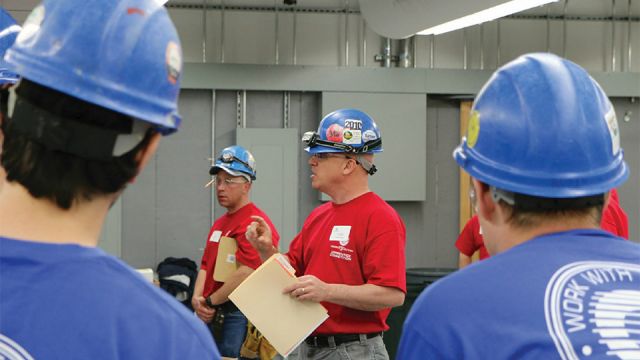Developing your existing workforce to overcome the labor shortage
How companies are increasing productivity within their current workforce
By Amy Saxton
As the industry continues to recover, the skilled workforce shortage will deepen as contractors compete for an ever-shrinking pool of skilled craft professionals. The Construction Users Roundtable (CURT) released a white paper in November titled “Skilled Labor Shortage Risk Mitigation” detailing how owners and contractors should work together to mitigate problems that result from the shortage. The paper outlines mitigation options to be considered and pursued during project planning. It also explains how improved workforce productivity is essential during a labor shortage because it allows projects to be completed with fewer hours and with a reduced need for additional craft professionals. There are many ways that contractors can actively increase productivity among their current workforce and position themselves to be more competitive.
Workforce planning
Multiple sources report a growing need for skilled workers with little relief on the way. The Construction Labor Market Analyzer (CLMA), an industry tool that produces actionable, real-time craft labor market intelligence, predicts that by 2018, the construction industry will need more than 2 million new craft professionals. In addition, ManpowerGroup, a global workforce solutions firm, has named skilled trades the No. 1 hardest job to fill for the last three consecutive years. Compounding the problem, the U.S. Bureau of Labor Statistics ranks construction as the third fastest growing sector nationally. Figures like these underscore the importance for all contractors to commit to recruiting new workers and preparing their existing workforce for upcoming projects.Early workforce planning is essential for owners and contractors to effectively manage project labor risks. Identifying potential workforce issues for future projects reduces surprises during the execution phase. Owners and contractors who use risk-management tools like the CLMA are able to plan and execute a project with certainty, knowing what labor shortage numbers to expect in the regions where they have upcoming projects. “We should have an equal focus on upgrading the skills of our existing craft professionals. Skill assessment and skill upgrade programs can increase the productivity of the existing craft workforce by as much as 10 percent, maybe even more.” Analyzing the local labor market and identifying potential labor shortages allows contractors to determine how they want to staff their existing workforce on current and future projects, as well as identify any recruitment needs. CURT’s white paper explains that because a local labor shortage can increase project costs and delay schedules, knowledge of labor availability should be part of the contracting process if owners want to maintain a high level of productivity and quality.
“When there’s a workforce challenge, it’s essential to accurately understand the level of supply and demand imbalance,” said Daniel Groves, president of the CLMA. “When owners and contractors identify what the shortage is for various crafts and when it will occur, then they can look at the available options. And fortunately, there are a host of options for planning based on the risk mitigation work that’s been done by CURT.”
Groves recommends that contractors who wish to mitigate labor risks during a shortage should do the following: train and upgrade skills for craft professionals; fill the craft pipeline with new entrants; relocate and schedule workers based on the needs of the project and market imbalances; advise the owner on challenges to more effectively plan; and prefabricate parts of the project offsite, if possible.
One organization that relies on the CLMA during planning is the Central Gulf Industrial Alliance (CGIA), a consortium of business and industry leaders along the Gulf Coast committed to improving industry performance and promoting best practices in the areas of workforce development, work safety, quality and productivity. CGIA provides its member contractors with a quarterly forecast report for the Gulf Coast region from CLMA and a biannual report from Alpha Resources, a consulting firm that provides craft compensation data. By providing these reports to its members, CGIA is ensuring their members have the information needed to make informed decisions about possible workforce issues.
“Forecasting, particularly forecasting of demand, assumes a certain level of productivity,” said Tim Johnson, executive director of CGIA. “If we can increase the productivity of the existing craft professional workforce, we may be able to reduce the huge demand for new workers.” Using tools that can assist in your forecasting can essentially help your bottom line.
Assessing your current workforce
Although recruiting will always be important, contractors who have a productive workforce may experience less pressure to recruit workers and therefore be less affected by labor risks. Identifying the strengths and weaknesses of your current workforce offers opportunities to upgrade the skills of individuals who are already committed to your organization. Knowing where your employees’ strengths are can help you make the most of their current skill sets, while identifying their weaknesses provides you the opportunity to focus specifically on the areas that will enhance their job performance. NCCER craft assessments provide a valid, detailed look at an employee’s knowledge by craft and topic areas through a training prescription that accompanies the assessment results. Through this process, training needs are immediately apparent and individualized training plans can be developed quickly. The training plans can help companies close their internal skills gap.“I believe that while the industry’s emphasis on recruiting new workers is critical, we are missing something,” said Johnson. “We should have an equal focus on upgrading the skills of our existing craft professionals. Skill assessment and skill upgrade programs can increase the productivity of the existing craft workforce by as much as 10 percent, maybe even more. These are individuals who have already chosen our industry, and we don’t need to recruit them.”
After doing an internal evaluation and beginning training for upgrading the skills of your current workforce, there still may be the need to recruit. Contractors can partner with national initiatives like Build Your Future (BYF) to recruit locally for upcoming projects. BYF is a collaborative, grassroots approach to workforce forecasting and development that includes recruitment, training, placement, retention and image enhancement strategies. Contractors can provide information about their available opportunities to potential recruits, parents and educators and highlight the value of a career in construction. It is critical for contractors to have a recruitment program in place to find skilled, long-term craft professionals, but it requires commitment, outreach and planning. Through outreach, contractors can promote a positive perception of the industry and attract talent.
Streamlining the hiring process
If it is determined that hiring new workers is necessary, then having an efficient hiring process can help workers transition to job sites more effectively. As competition increases among contractors to hire skilled professionals, there has become a need to accelerate and streamline the hiring process in order to attract and hire recruits. Onboarding is a process that enables contractors to staff their projects and send workers to job sites quickly. The extent to which organizations prepare new hires for their jobs plays a role in a workforce’s potential productivity. Turner Industries in Baton Rouge, Louisiana, recently developed a comprehensive onboarding process that shortened their hiring process for craft professionals from days to hours and is accomplished almost entirely in-house.Prior to developing the new onboarding process, Turner would send recruits to multiple facilities around town to accomplish what they needed to start working. Recruits went to a local safety council to take the required assessments for industrial companies’ orientation and certification. Then they went to another facility to receive respirator fit testing and yet another facility to take a drug test. In addition to these trips, craft professionals also went to the local Associated Builders and Contractors chapter to take NCCER assessments.
All of these steps were brought in-house in 2010 at Turner’s new personnel and training facility in Baton Rouge. Turner has a safety council employee who conducts safety assessments in their office and a physician’s assistant who performs medical testing. The new hiring process has increased Turner’s ability to send the best and most skilled craft professionals to job sites faster. The onboarding process includes seven steps: processing, recruiting, applying, craft testing, medical testing, assessing, training and consulting.
“Onboarding has reduced the number of recruits who were frustrated with the lengthy process and left,” said Ray Neck, training manager for Turner Industries. “Our main goal is to make things easier for our recruits, our staff and our clients. The requirements and steps to bring on new people in our industry are very extensive, so our process makes things easier and more welcoming.”
In addition to the Baton Rouge facility, Turner also has two other training and hiring facilities in Texas and a new facility opening next year in Lake Charles, Louisiana. In all, approximately 100,000 recruits have been through the new hiring and training process among the three existing facilities and 35,000 were offered employment in each of the past three years. The Baton Rouge facility had a single- day record of 246 recruits go through the process.
“We can send our craft professionals to jobs significantly faster now,” said Stevie Toups, senior vice president of Turner Industries. “The faster they can start working, the more money they can make. No one wants to sit around a personnel office. We wanted the process to be accomplished in a timely manner.
Training
The Construction Industry Institute’s (CII) Research Team 252 conducted a five-year productivity study and determined that contractors who actively develop their workforce experience a higher level of productivity than those who do not. The study shows that when contractors invest 1 percent of their total project labor budget on training, there is an estimated 11 percent improvement rate in productivity for capital projects. Contractors who train craft professionals have a more productive workforce and are better prepared when labor shortages occur. Contractors who do not train their workforce often lack dedicated, skilled workers who can grow with the company and perform work effectively. Ultimately, contractors who do not invest in training will have workers who are less loyal and perform their work in a less productive manner.Cianbro, based out of Pittsfield, Maine, offers a pre-apprenticeship program that provides formal training for new employees and laborers who are unsure about what career path to take. The program lays the groundwork for various crafts, so workers can choose a career path that best fits their interests. Other employees are hired with the intent to go straight into a specific apprenticeship program. “Research shows that when contractors invest 1 percent of their total project labor budget in training, there is an estimated 11 percent improvement rate in productivity for capital projects.” Those employees can choose one of four apprenticeship programs offered by Cianbro that are registered in the state of Maine: Electrical, Pipefitting, Millwright and Line Worker. Cianbro also offers an Ironworking training program, and all five of their programs are NCCER accredited. After proving themselves in the first year of the apprenticeship program, apprentices can then move on to the second level.
Cianbro’s training program benefits the company in many ways. The overall skill level of their workforce is elevated because they provide entry-level and low-skilled workers the training and skills to work in new occupational areas, which increases their ability to obtain and perform certain types of work. In addition, craft professionals who are formally trained are typically more motivated in their careers, make better decisions and perform with a higher level of skill. Finally, by developing younger talent from within, journey-level workers can take on new roles in the company as mentors, instructors, supervisors or project managers, among others.
Another contractor, TIC – The Industrial Company, brings in trainees from project sites all over the country once a year for three weeks to train at their training center in Steamboat Springs, Colorado. Instructors teach a variety of NCCER curricula including Core Curriculum, Concrete Finishing, Electrical, Instrumentation, Ironworking, Millwright, Pipefitting, Rigging, Safety and Welding. This style of training increases productivity because it allows trainees to receive the required 150 hours of formalized training in three weeks and then take that knowledge to the field and apply it. trainees repeat the process annually for four years before completing the program. Jeff Rodenberg, director of TIC’s Craft Training Center, believes this style of training is a wise investment because it enables apprentices to leave the job site and concentrate on the skills they are learning.
“We love to get men and women into our training program early in their career,” said Rodenberg. “This allows them to get all of the classroom and technical skills that they will need as they progress from laborer to helper to journeyman. We also bring in more experienced craftsmen to attend the higher-level classes for skills upgrade training.”
After completing their training, many of TIC’s former trainees go on to become general foremen, superintendents and project managers in the company. Superintendents on project sites are accustomed to the threeweek training model and know they will be without their apprentices during that time. They understand their trainees will return better than before they left.
Electrical contractor Wayne J. Griffin Electric, Inc. in Holliston, Massachusetts, offers not only a federally recognized and NCCERaccredited electrical apprenticeship program, but also numerous other training programs to maintain a productive workforce. Wayne J. Griffin Electric finds that internal training programs can motivate and encourage employees, thus leading to a more engaged workforce. Many employees will move into leadership roles and are more likely to stay with the company for a long period of time. Graduates of the apprenticeship program may gain experience as journeymen then choose to teach or become foremen or project managers. Some of the programs Wayne J. Griffin Electric provides employees include project engineer and professional development training.
The eight-week project engineer training program provides recent college graduates with an overview of the company and outlines their progression through a career development path. The professional development training program is offered to all employees and teaches soft skills, leadership skills, health and wellness, personal effectiveness and Microsoft Office programs.
“Our people are our biggest asset,” said Donna David, corporate human resources manager at Wayne J. Griffin Electric. “The more we invest in them, the more we benefit as a company.”
Career paths
According to the report “Entering the Human Age” from ManpowerGroup, talent and human potential is replacing capital as the new dominant resource required for companies to expand and prosper. Essentially, capitalism is evolving into talentism. Therefore, power and choice are shifting towards those who are talented and skilled. Skilled individuals, who are in increasingly short supply, want to own their careers and choose to work for employers and industries with the best career development paths.This means it is more important than ever for contractors to create internal opportunities for their workforce by developing career pathways within their company. Clearly defined career paths help promote a long-lasting, loyal and productive workforce. As paths of opportunity widen, employees at all levels become more committed. Contractors who train their existing workforce have more knowledgeable and skilled craft professionals to grow within the company.
Turner Industries has developed individual career paths for each craft to help trainees identify the potential career progression within the company. These plans detail the career path that craft professionals can take based on their current position, experience and training level. Employees can use the career path to determine what role they ultimately want to have in the company and follow the steps to get there. The process specifies when training and assessments need to occur in order to advance to the next step, as well as how certifications and experience apply to achieve specific positions.
Turner’s construction career path begins with tier-one employees: high school graduates, entry-level workers and helpers. For tier-one employees looking to advance to the second tier, there is a craft training and certification process they must complete. This part of the process includes NCCER training and assessments. After employees become NCCER Certified Plus, they can move on to the second tier, which includes craft professionals and craft leaders. Successful second tier employees can advance into the multi-tier level of employment, which includes project controls, supervision, quality assurance and quality control and safety. These positions lead to the last tier in the organization, upper-level management.
“We take pride in developing our people and keeping them for long periods of time,” said Neck. “We see and meet their needs as they come along. The world out there is always changing, and we are always looking for ways to better serve our people. It’s important to make it as easy as you can on your employees. Treat them right, and they will treat you right.”
Upward mobility
Career paths, training and assessments all give craft professionals the direction and skills they need to advance in a company. As a result, contractors who invest in developing their workforce are better prepared to meet the challenges of the workforce shortage. Clearly defined career paths coupled with training and assessments offer new avenues for personal growth, talent exploration, new connections and more visibility in the company.One way for contractors to promote upward mobility is through assessments. As previously mentioned, assessments allow contractors to elevate the skill level of their workforce and implement training plans as needed. In addition, assessments provide craft progression opportunities to workers, which encourage employees to stay in their companies.
After craft professionals develop experience as journeymen, they can take supervisory assessments to advance in their careers within a company. Cianbro offers NCCER Supervisory Assessments for front-line supervisors. The assessments give workers recognition for their knowledge of foreman or superintendent skill sets. As a result, workers take pride in their skills and level of training. Assessments can also be eye opening to other workers and encourage them to improve their knowledge and skills.
“We encourage our craft professionals to grow,” said Jonathan Sacks, training manager for Cianbro. “The culture of our company is to promote from within, so most of our executives worked their way up. This shows that there’s a lot of opportunity for employees to step up because we are constantly growing.”
Another way Cianbro promotes upward mobility is by re-socializing employees to the current, evolving culture and the emerging opportunities in the company through their leadership program. Over the last 10 years, the program has had 40-60 employees participate each year from all levels in the company, ranging from craft professionals to project managers. The purpose of the program is to respond to current industry needs and initiate change in the company.
Participants are introduced to fundamental leadership concepts and work as a team to create a future vision for the company. The 12-week leadership program begins with a three-day opening session, during which the participants come up with ideas that will significantly enhance the organization by improving current business practices, creating new ways to perform tasks and integrating new technology. At the end, the team presents projects and ideas, as well as steps to move the initiative forward to senior management.
“The program has a wide cross section of experienced and new employees within the organization,” said Sacks. “The new employees bring a lot of energy and new ideas, so the cross pollination works really well.”
Evaluating your overall workforce development program
In order to have an effective workforce development program, each of the elements presented here should be included in a company’s program. The newly released Contractors Workforce Development Assessment (CWDA) objectively measures the quality of a contractor’s workforce development program and their commitment to it. Developed by NCCER and CURT, the CWDA can motivate contractors to train and improve their workforce.The CWDA includes an assessment for construction managers, self-performing general or prime contractors and subcontractors. The assessment enhances the ability of contractors to evaluate their own workforce development program, as well as their subcontractors’ programs. Assessment questions cover topics ranging from the availability of portable credentials within a craft training program, the use of industry-recognized curricula, the structure of a craft progression program and the support for upgrade training for credentialed journeymen. Contractors must provide detailed, supporting documentation for each answer. This process enables contractors to deeply examine all the components of their training program and identify strengths and weaknesses. Contractors with a high CWDA score typically experience improved productivity and safety within their workforce, as well as less absenteeism, turnover and rework. They also report having significantly lower Experience Modification Rates (EMR), Total Injury and Illness Rates (TIIR) and Days Away, Restricted or Transferred (DART).
“The CWDA is a valuable tool to help contractors elevate their engagement and commitment to workforce development,” said Don Whyte, president of NCCER. “The CWDA can fundamentally change the landscape of workforce development in our industry.”
Bringing it all together
With competition increasing among contractors to recruit from a limited pool of skilled craft professionals, progressive contractors are finding ways to elevate productivity within their existing workforce. By forecasting anticipated labor risks for upcoming projects, contractors can assess their current workforce and determine their labor needs accordingly. If hiring new workers is required, then having an efficient hiring process can offer contractors a competitive edge when recruiting craft professionals who want to work right away. After coming on board, new workers who receive training can increase the overall skill level of the workforce as they advance in their careers. Career paths identify the training and skills that are required for craft progression and upward mobility within the company. Using tools like the CWDA, contractors can evaluate their workforce development program to include all the necessary components to train and improve their workforce.As contractors increase productivity levels within their existing workforce, then the need to recruit and the effects of the shortage can be lessened. By expanding productivity within a company, the knowledge, skills, motivation and loyalty of a workforce improves and contributes to a more sustainable company culture. At the end of the day, when contractors narrow their internal skills gaps, then the skills gap for the industry as whole is reduced.
About the Author
Amy Saxton is the Communications Manager at NCCER.
This article was originally published in the Fall/Winter 2014 edition of NCCER’s The Cornerstone magazine (http://www.nccercornerstone.org/publications/publications-archive). This content has been republished with the permission of NCCER and the publisher.



















